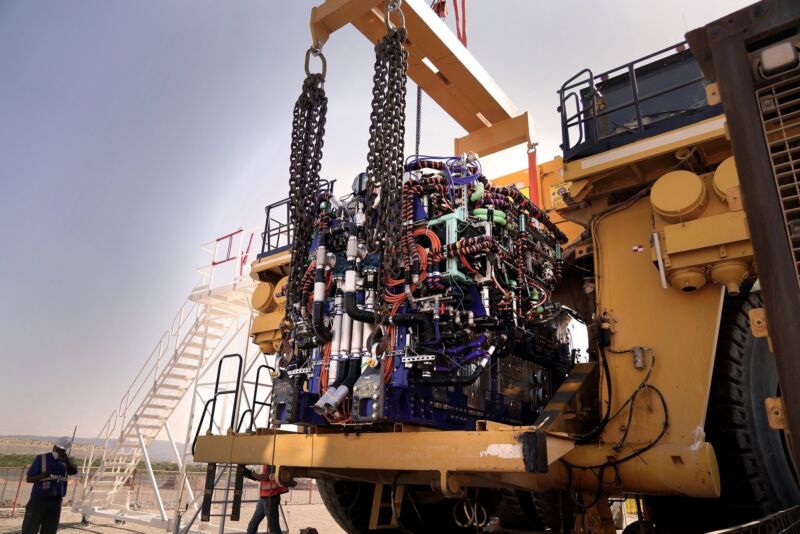Mining giant Anglo-American has put to work a prototype of what it says is the world’s largest hydrogen-powered vehicle.
The 210-ton truck uses hydrogen fuel cells that generate 2MW of electrical power, the company said in April. Originally, this beast was a Komatsu 930E with a diesel-electric powertrain, but after a dramatic conversion, it was turned into a veritable monster capable of carrying a payload of close to 300 tonnes.
The hydrogen vehicle is part of Anglo American’s nuGen Zero Emission Haulage Solution (ZEHS) and “a fully integrated green hydrogen system, consisting of production, fuelling and haulage system, with green hydrogen to be produced at the mine site” – its Mogalakwena platinum mine in Limpopo, South Africa.
The company said it worked with some of the world’s leading creative engineering and technology companies, such as ENGIE, First Mode, Ballard and NPROXX, to design, build and test its 1.2MWh battery pack, “as the haul-truck system uses multiple fuel cells that deliver up to 800kW of power, combining to deliver a total of 2MW of power.”
It also built a hydrogen production, storage, and refuelling complex at Mogalakwena, the world’s largest open-pit platinum mine, that incorporates the largest electrolyser in Africa and a solar plant to support the operation of the mining truck.
ALSO SEE: Falling green hydrogen costs aid clean energy push
Are Green Hydrogen Vehicles Viable?
“This is an important step on our pathway to carbon neutral operations by 2040,” chief executive Duncan Wanblad said. “The mining industry is playing a considerable role in helping the world decarbonise, both through our own emissions footprint and the metals and minerals that we produce that are critical to low carbon energy and transport systems.
“Over the next several years, we envisage converting or replacing our current fleet of diesel-powered trucks with this zero-emission haulage system, fuelled with green hydrogen. If this pilot is successful, we could remove up to 80% of diesel emissions at our open pit mines by rolling this technology across our global fleet.”
Anglo American says hydrogen power can enable a shift to greener sources of energy and cleaner mining equipment and that “the hydrogen economy provides an opportunity to create new engines of economic activity.”
Given abundant natural gas and renewable energy sources, such as solar and wind power, “hydrogen is a strategic priority for South Africa and presents a significant opportunity for economic development,” it says.
Hydrogen Valley: A Clean Energy Hub
South Africa’s Department of Science and Innovation (DSI) and the South African National Development Institute were also looking at creating a Hydrogen Valley, it said, in partnership with Anglo American, Bambili Energy and ENGIE.
“The proposed hydrogen valley will stretch approximately 835 kilometres from the platinum group metals-rich Bushveld geological area in Limpopo province, along the industrial and commercial corridor to Johannesburg and to the south coast at Durban.
“Nine key pilot projects have also been identified across these hubs and are recommended to be prioritised by developers. They span the transport, industrial and construction sectors,” the company said.
• By Jim Pollard
ALSO on AF:
Japan’s Osaka Gas Backs $11bn Hydrogen Project in Australia
Falling Green Hydrogen Costs Aid Clean Energy Push
Thyssenkrupp Hydrogen Unit Plans to Take on China, Japan Rivals
Woodside, Keppel to Study Hydrogen Supply to Singapore, Japan
Sinopec Starts Building Green Hydrogen Plant in Xinjiang
‘Green hydrogen’ hailed as a way to clean up the steel industry
























